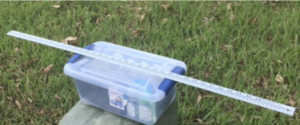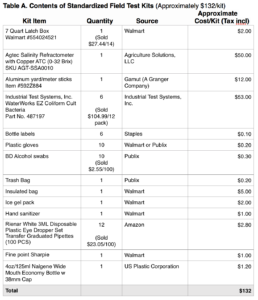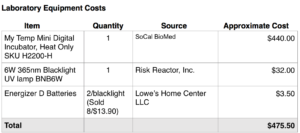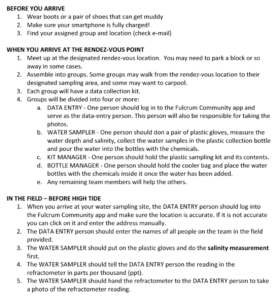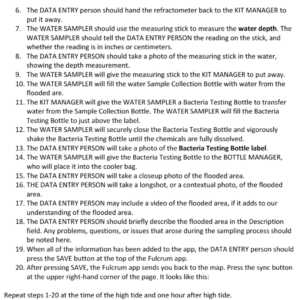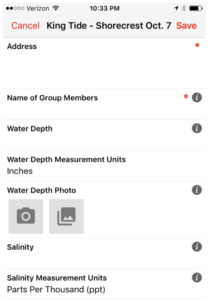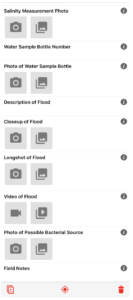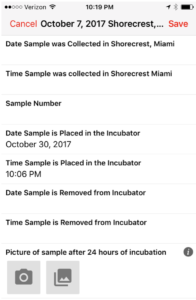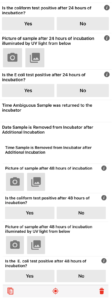Community Science
Materials and methods for documenting the depth, salinity, and presence or absence of coliform and E. coli appear below.
Standardized King Tide Field Test Kits with Bacteria Test Sampling
To create a portable system that can be replicated anywhere there is flooding, and to create a simple training program that can prepare organizers to take the system into any community, a standardized Field Test Kit was prepared. The system is designed to support data collection on depth and salinity of the water, as well as collection of water samples and appropriate cooling of water samples prior to incubation required for coliform and E coli testing. Stackable plastic bins with content described in Table A below are easily loaded into a vehicle and delivered to a sampling site. Each Test Kit was equipped with 6 EZ Coliform Cult (XGAL/MUG) EPA compliant tests. Each Test Kit was expected to be used at 2 sampling locations, at 3 different times in the tidal cycle. In addition to the Field Test Kit contents, field teams also needed drinking water, a cooler with cold packs, extra labels, extra fine point Sharpies, tape to secure labels, and extra boots or waders for people who arrived without them.
Closed Prototype Field Test Kit
With Aluminum Meter Stick, September 18, 2017
Photo by Janice T. Booher, MS
 The plastic latch boxes on the prototype kits had lids that made the kits stackable,which was important in packing and delivering the kits to the field. The picture on the left shows the lower layer of the packed kit. The disposable plastic eye droppers are below the plastic gloves.The picture on the right shows the six EZTM Coliform Cult (X-GAL/MUG) sample bottles, which contain the reagent that detects enzymes produced by coliform and by E. coli.Subsequent Test Kits also contained a 120ml sample collection bottle. September 18, 2017
The plastic latch boxes on the prototype kits had lids that made the kits stackable,which was important in packing and delivering the kits to the field. The picture on the left shows the lower layer of the packed kit. The disposable plastic eye droppers are below the plastic gloves.The picture on the right shows the six EZTM Coliform Cult (X-GAL/MUG) sample bottles, which contain the reagent that detects enzymes produced by coliform and by E. coli.Subsequent Test Kits also contained a 120ml sample collection bottle. September 18, 2017
Photo by Janice T. Booher, MS
Creating Standardized Field Test Kits made it possible to train a cohort of New Florida Majority Climate Justice Organizer Trainees, which included Shorecrest residents. Organizers trained on the Field Test Kits can train more residents in Shorecrest, or train residents in other communities where there is flooding. After experiencing field and laboratory procedures on September 19-20, 2017, Janice Booher created a FULCRUM App to record the October 7, 2017 coliform and E coli results, and shared the dataset created with FIU Sea Level Solutions Center both by sharing Dr. Susan Jacobson in on the account and by email. Testing for the presence or absence of coliform and E coli using the EZ Coliform Cult (XGAL/MUG) EPA compliant test was added to the FIU “Citizen Science” protocol developed by the FIU Sea Level Solutions Center, and used in Shorecrest. Systematic numbering of water samples collected is necessary to correlate bacteria sample results with data uploaded in the field.
“Citizen Science” King Tide Information Gathering
FIU’s Sea Level Solutions Center has been engaging citizens in King Tide data collection that can be uploaded using a, “Report a Flood” form available in the “King Tide Measuring Manual.” Standardized Field Test Kits, designed in collaboration with Dr. Tiffany Troxler (Director, FIU Sea Level Solutions Center) and Dr. Susan Jacobson (FIU Department of Communication + Journalism), were successfully piloted by training FIU students and Shorecrest residents to collect depth, salinity, narrative information, pictures and videos in the flooded streets of Shorecrest on September 20, 2017 and October 7, 2017. In addition, pictures of sample bottles with a bottle number, date, location and time were taken in the field and uploaded.
Quality control measures included in the King Tide field data protocol include uploading photos of all physical measurements, so numbers entered by citizens reporting a flood can be verified, capturing metadata establishing location from the mobile devices used to upload the information, uploading close-up and long shots of the sampling site, and uploading videos with a narrative to confirm location. All photo and video data can therefore be used to verify location. FULCRUM data sets present as spreadsheets. Column headings correspond to the FULCRUM App fields into which the data was entered. Pictures appear in the spreadsheet, and URLs to videos are recorded in the spreadsheet.
Before Hurricane Irma, when the number of people that would participate on the field team during the King Tides was still unknown, Dr. Tiffany Troxler prepared a Proposed Sampling Plan and Proposed Field Kit Content list, which appears on page 104. The sampling plan was adjusted for the number of participants, and locations that were experiencing flooding.
Dr. Troxler also identified the EZ Coliform Cult (XGAL/MUG) EPA compliant test as appropriate for Citizen Science. In the field, water is poured into the sample bottles, which already contain the reagents in the correct proportions. After incubation, the media turns blue-green if coliform bacteria is present, and shows blue fluorescence under UV light if E. coli is present. Although this simple test does not yield information about the identity of the bacteria present, nor does it yield a bacterial concentration, it can provide information about where coliform are found. Coliform presence is an indicator that other pathogens may exist, so more complete testing could be done at identified locations. If tested over time, temporal or seasonal distribution patterns could be analyzed. The EZ Coliform Cult (XGAL/MUG) EPA compliant test has a sensitivity of 1 colony forming unit/100ml. A positive coliform result indicates that residents should avoid ingesting the floodwater, so children and pets should not be allowed in floodwaters, because they might put fingers or paws in their mouths after contact
Community Map Data Collection Process
Community Map Fulcrum App
In February of 2017 FULCRUM “Fulcrum Community” was launched as a no-cost, short term crowd sourced data collection platform for humanitarian projects that FULCRUM approves on a case by case basis prior to activating the account. The data is anonymized, free, and open to all by default, with restricted commercial use. Fulcrum Community was created for disaster response applications.
The following images are screen shots from a cell phone. Field data is collected by responding to each of the prompts, which are stored in the phone. Pressing Save synchronizes the data, and makes it available in spreadsheet form to account administrators.
EZTM Coliform Cult (X-GAL/MUG) Test Process
This procedure is based on field water samples placed in numerically labeled, sequenced sample bottles. If the samples are numbered, and the samples are placed in and removed from the incubator in numerical order, the amount of time to process the samples will be greatly reduced.
Field collection process is explained in steps 11-14 of the Community Map Data Collection Process
- Collect all sample bottles from field teams, and place them in a cooler with cold gel packs.
- Transport the cooler with samples to an incubator set at 35° C (95°F).
- Place the samples in numerical sequence using the number printed on the bottle label.
- ENTER the date and time the sample was collected in Shorecrest into the FULCRUM app.
- ENTER the number of the sample that is printed on the label.
- Place the sample in the incubator.
- ENTER the date and the time the sample was placed in the incubator.
- Repeat Steps 4-7 for all samples.
- Incubate the samples at 95 degrees Fahrenheit for 24 hours.
- When the samples are removed one at a time from the incubator, make sure that they are placed on a transportable surface in numerical order (like a small table or chair with wheels, so you will be able to transport the samples to a dark room later).
- ENTER the date and time the sample was removed from the incubator.
- UPLOAD a picture of the sample. Make sure the color of the sample is visible. The labels may obscure most of the bottle, but be sure that the color of the liquid is visible in the picture.
- ENTER the answer to the question: Is the coliform test positive after 24 hours of incubation? If the sample is clear yellow it is negative for coliforms, and the answer is NO. If the sample is positive for coliforms it is blue-green, and the answer is YES.
- If the sample was ambiguous for any reason, you must incubate it for another 24 hours. If this is the case, follow Steps a-e:
a. ENTER the time and date the sample was placed in the incubator for additional incubation.
b. Incubate at 95 degrees Fahrenheit for an additional 24 hours.
c. ENTER the date and time that the sample was removed from the incubator after additional incubation.
d. UPLOAD a picture of the sample after 48 hours of incubation. Make sure the color of the sample is visible. The labels may obscure most of the bottle, but be sure that the color of the liquid is visible in the picture.
e. ENTER the answer to the question: Is the coliform test positive after 48 hours of incubation? If the sample is clear yellow it is negative for coliforms, and the answer is NO. If the sample is positive for coliforms it is blue-green, and the answer is YES.
- Transport the samples to a dark room, maintaining their numerical order.
- Shine a UV light with a wavelength of approximately 365nm from the bottom of the sample.
- UPLOAD a picture of the sample with the UV light shining through it.
- Answer the question: Is the E. coli test positive after 24 hours of incubation. If there is bright blue fluorescence the test is positive, and the answer is YES. If there is no bright blue fluorescence the test is negative, and the answer is NO.
- Press Save in the upper right corner of your screen.
- Press the Sync button in the upper right hand corner of the screen.
EZTM Coliform Cult (X-GAL/MUG) Test Process FULCRUM App
Community Science Quality Assurance Project Plan
There is a need to develop a Data Workflow Process for physical data collection. There needs to be an characterization of data quality associated with community-based participatory research when there is field sampling and laboratory analysis conducted by “citizen scientists.” Rising Together survey projects use a system of stipends and memoranda of understanding that could easily accommodate positions of responsibility in field data collection and simple laboratory testing to document accountability.
The Rising Together Community Science QAPP Template has been filled out with responses common to all Coliform and E. coli presence/absence testing using the EZTM Coliform Cult (X-GAL/MUG) Test in floodwaters. Project leaders doing citizen science must insert details unique to their projects, and eliminate fields that are not relevant to their project. This will assist Citizen Scientists to create QAPPs for their projects. Once signed by the appropriate parties, the QAPPs could be posted on a regional open source platform together with data sets and URLs of maps created as work product to address quality concerns. This would give researchers a means of evaluating the quality of data sets from citizen science community-based participatory research. Congregations and community groups engaged in Rising Together projects will have assistance drafting their QAPPs.

